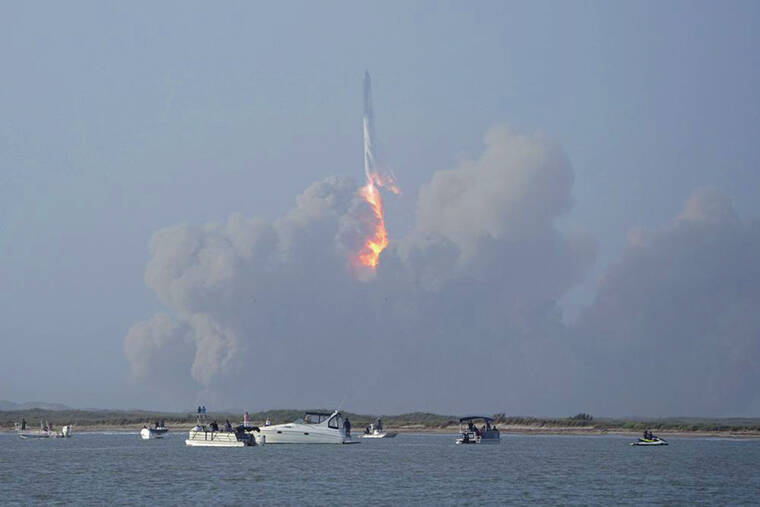LIHU‘E — The largest rocket ever built will not splash down off the coast of Kaua‘i as planned after it exploded over the Gulf of Mexico four minutes into its inaugural flight.
The 390-foot tall SpaceX Starship took off from a launchpad in Starbase, Texas, early Thursday morning, April 20, with 16.5 million tons of thrust — more than double the power of the previous record-holder. It was supposed to soar 145 miles above Earth’s surface before reentering the atmosphere and landing in the ocean about 62 miles from the northwest coast of Kaua‘i.
But as the rocket ascended 24 miles, it experienced what SpaceX referred to as a “rapid unscheduled disassembly,” turned sideways and dropped out of the sky. The rocket’s self-destruct system was deployed, causing it to explode and plummet into the water.
The explosion was not entirely unexpected — rocket tests like this always have a good deal of uncertainty baked into them.
Other Starship prototypes had exploded in four out of five previous tries, and SpaceX founder Elon Musk had given the most recent effort a 50-50 chance of success. On Twitter on Thursday, he described the launch as “exciting,” and said they had “learned a lot for the next test launch in a few months.”
NASA administrator Bill Nelson praised the company on getting the rocket off the ground, despite its fiery end.
“Every great achievement throughout history has demanded some level of calculated risk, because with great risk comes great reward,” Nelson wrote on Twitter.
The Federal Aviation Administration, which gave the OK for the launch last week, has grounded the rocket, and is investigating the cause of the explosion.
“An anomaly occurred during the ascent and prior to stage separation resulting in a loss of the vehicle,” the FAA wrote in a statement. “No injuries or public property damage have been reported.”
SpaceX has big plans for the Starship model, which they ultimately hope to use to carry people and cargo to Earth’s orbit, the Moon and Mars.
They also claim it will eventually be capable of “point-to-point transport on Earth, enabling travel to anywhere in the world in one hour or less.”
The private company is massively subsidized by taxpayers, receiving a total of $15.3 billion from the government since 2003.
No splashdown
Recently released documents filed with the FAA described what the dramatic landing near Kaua‘i would have looked like.
Unlike the “soft ocean landing” described in a less detailed 2022 filing, the documents released on April 14, 2023, stated the rocket would hit the ocean “at terminal velocity,” triggering an explosion when remaining fuel sources combined. At the point it hit the ocean, the rocket would have contained 10 metric tons of liquid oxygen and 4 metric tons of methane.
SpaceX would then have coordinated with the U.S. Coast Guard on a salvage operation. Most debris was expected to sink to the ocean floor because it is made of steel.
“Though not expected and unlikely, if there is floating debris found by the vessel during the debris field survey, SpaceX would sink or recover any floating debris … by physically removing the item or puncturing the item to cause it to sink,” the document reads.
The remaining debris could be punctured “using a firearm or remote operating vessel.”
The document states the descent and landing “may affect but are not likely to affect” endangered species living in the area. In an analysis that examined the potential effects of debris on marine wildlife, SpaceX projected the operation would affect less than one endangered marine creature.
•••
Guthrie Scrimgeour, reporter, can be reached at 808-647-0329 or gscrimgeour@thegardenisland.com.



15.3 billion dollars…. How many people in need could this have helped? And it’s funded by taxpayers! Incredible.